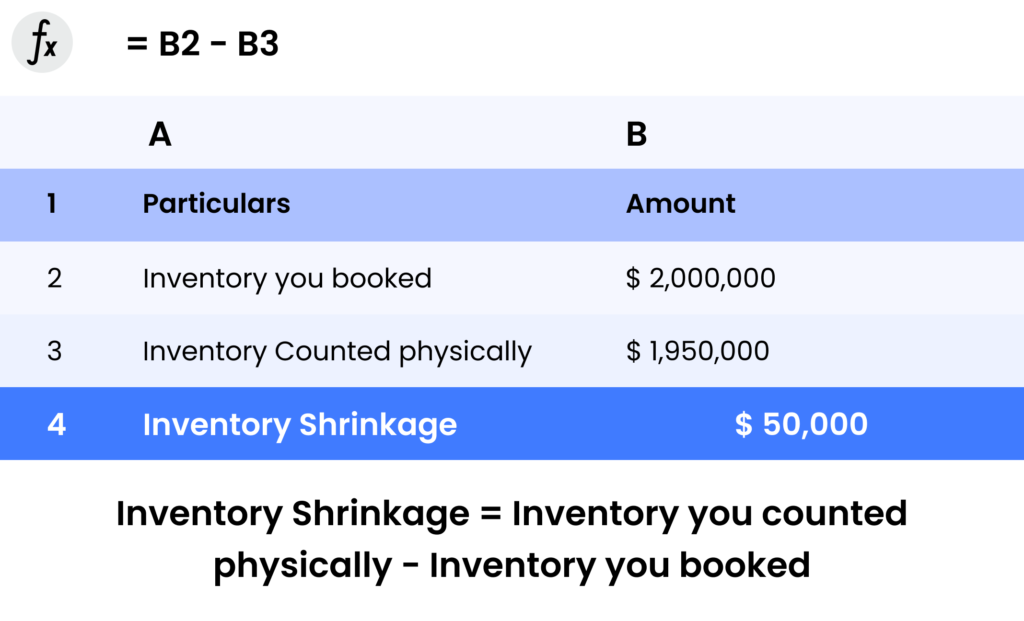In this article, we discuss,
- What is the shrinkage of inventory?
- How to calculate inventory shrinkage for your business?
- How to calculate your business inventory shrinkage rate?
- What causes inventory shrinkage?
- When to record inventory shrinkage?
- How to prevent inventory shrinkage?
- Inventory Shrinkage Example
- Inventory shrinkage journal entry
Inventory shrinkage is one of the common issues. Stock shrinkage will result in your business in profit drop. In some cases, it may lead you to change your accounting books and result in a loss of time and money. Shrinkage may happen due to various factors and may occur in combination or even singly. Some of the factors for shrinkage include customer theft or employee theft, shipping errors, don’t have effective recordkeeping, stock misplacement, and so on.
What is inventory shrinkage?
In simple terms, inventory shrinkage is, shrinkage refers to inventory that is unaccounted for; it’s missing, stolen, or destroyed. Stock shrinkage occurs when the stock product counts are less than the recorded inventory lists. In general, it is more important for your business to prevent inventory shrinkage.
How to calculate inventory shrinkage for your business?
Analyzing and tracking your inventory levels are considerably more important for an accurate count of stock shrinkage.
With the help of recorded inventory and its actual count, you can calculate your accurate inventory shrinkage. Here is the formula to calculate the inventory shrinkage for your business.
Inventory Shrinkage = Recorded Inventory Count – Actual Inventory Count
Here, your recorded inventory count either comes from a manual count or an integrated POS system.
How to calculate your business inventory shrinkage rate?
The inventory shrinkage rate is used to track the goods lost percentage from your actual recorded inventory list. To calculate your inventory shrinkage rate, use the below formula,
Inventory shrinkage rate = (Inventory shrinkage / Recorded inventory count) * 100
Where, Inventory shrinkage = Recorded Inventory Count – Actual Inventory Count.
What causes inventory shrinkage?
There are as many reasons for the cause of inventory shrinkage, which may vary from business to business. Here follows the typical stock shrinkage for businesses,
- Shoplifting
- Supplier fraud
- Employee theft
- Administrative errors
- Unknown causes
1. Shoplifting
Shoplifting is an ongoing problem for most retailers. It takes place when a customer walks out of a store with items they did not pay at the cashier. Around 38% of stock shrinkage is caused because of shoplifting. Prevent inventory loss and shrinkage by being conscious of your customer’s payment process.
2. Supplier fraud
Theft can occur when you’re trading with partners who don’t have the best reputation. Theft may also happen while you’re not present, for example, when your products are being transported from one place to another. To forestall this fraud make your presence at an important place and the deliveries should be counted every time before they enter and after they leave the business.
3. Employee theft
Since most employees deal directly with all your products, they may steal your inventory. 42% of inventory reduction occurs due to employee theft and you should be more conscious of it, to prevent inventory shrinkage. Using CCTV, Security and proper warehouse management are some of the best practices to prevent inventory shrinkage.
4. Administrative errors
At present, the most business has moved their paperwork task to digital methods for maintaining their record-keeping. But also, administrative errors are one of the main causes for most businesses. Accidental reorders, adding or missing zeros, or missing decimal points can cause problems with administrative errors. To decrease and prevent this sort of error, even when you use automated systems, it’s important to make sure the count is accurate.
5. Unknown causes
At some point, inventory may vanish from its place and this type cause mismatches with another inventory reduction.
When to record inventory shrinkage?
The inventory shrinkage is recorded when
- When your item/stock gets expired and is no longer available to sell
- When there is damage to the stock
- When you hunt, found, or have doubts about employee theft or customer theft, or vendor theft
- When there is a mismatch in your withholding inventory and accounting books
The above are some of the common periods to record inventory shrinkage. Further, recording your retail and other businesses’ stock reductions will help you check your item’s trends and flops
How to prevent inventory shrinkage?
Prevent your inventory shrinkage with the below-followed point.
1. Make sure to invest in surveillance
Investing in surveillance is a better way to prevent your inventory shrinkage and also help you in inventory audits. Just install and place CCTV surveillance around all your stock location. Additionally, the theft warning signs will help you in inventory shrinkage reduction. Monitor it regularly and take action in case of any suspicious found. CCTV and warning signs are the best security for your inventory stocks.
2. Choose the right person for your inventory management
Pick one of the suitable employees for inventory management. The person in the post of inventory as a manager should know all in and out of inventory management. They must have the capability to issue an in-depth inventory report including, incoming and outgoing stocks, valuation of stocks, quality of stocks, depreciation, and much more. Additionally, the inventory manager is responsible for purchase order handling, inventory audit handling, and so on. Choosing the right inventory management system with myBooks will help you prevent some sort of inventory shrinkage.
3. Reduction in temptation
To prevent and reduce on-premise theft, store your highly-valued products in a secured area and make the area secured with security or a CCTV. Planning in this way helps in inventory shrinkage reduction and prevents inventory shrinkage. This makes the shoplifters steal the high-valued products.
4. Track your inventory levels periodically
Monitoring your inventory stocks and levels periodically reduces inventory shrinkage. Set inventory at the minimum level. Once you notice the number close to the minimum level, make sure to reorder them without any delay. Avoid storing excess inventory in one place, which may cause obsolescence, damage, decay, and other issues. Doing so will help you determine the right amount of purchases.
5. Prevent fake code promotion
Promoting your products to increase your leads and sales is better and preferred for your business. But be precautious with the scammers. They take more advantage of your promotions. When many stores advertise discounts, it’s easier for scammers to circulate fake coupons. During this period, manufacturers may find these discounts are not valid and may revoke them. These reimbursements are very important to your business, so you need to protect against their loss.
6. Make sure to create an SKU number and barcode for all items
Both the SKU number and the barcode help track inventory for all your items. If you label your items, you’ll get the best of both worlds. You’ll be able to track your inventory, and easily get barcodes that allow you to generate barcodes that are compatible with an inventory management system and barcode scanners. Make sure to use this opportunity to reduce the inventory shrinkage.
7. Perform regular inventory audit
Never forget your inventory audit. Compare your available stock in your physical location with the recording stock in the accountant system. This is called stocktaking. Make sure both recorded accounting and the inventory match. There is no exact period for this type of audit. Perform this action whenever necessary. Auditing your inventory items periodically helps in inventory shrinkage reduction.
8. Avoid Fabricated Sales Transactions
Many types of sales fraud exist, including offering discounts in excess to the customer’s, false vendor bills, and more. There are certain actions to overcome and prevent this kind of issue.
Some of the actions follow below,
- Try to split up important responsibilities; other people will need to get involved in any step fails.
- You can set control over who can access your finances.
- Make sure to examine your business operations regularly to be sure that you’re operating according to best business practices.
9. Prevent Inventory shrinkage with automatic inventory management
Using automated inventory management software like myBooks will help you to reduce and prevent administrative errors. This is one of the better ways to manage your inventory. You can use it to control your inventory, including the quantity and location of inventory items.
Inventory Shrinkage Example
Let’s consider an example. You have an inventory record that shows as $6000. It might arise because — you had $7000 worth of stock, sold $3000, and purchased for $2000. Total the inventory’s actual value you hold. This value may vary from the book value, due to theft, damage, losses, or other reason.
Now, subtract the inventories of actual cash from the cash that you should hold, based on your financial records. For example, you might be predicted to have $6000, but if you have only $5900, you would subtract $5900 from $6000 to get $100.
i.e, $6000 – $5900 = $100
Just divide the received difference by the cash you have to estimate the rate of shrinkage. Based on our example, you will divide $100 by $6000 to get $0.06.
i.e., $100 / $6000 = $0.06
Now multiply the estimated shrinkage by 100 to convert the value into a percentage. As per the above example, you multiply 0.06 * 100 to get 6% as the stock reduction rate.
Example
Here is an example of inventory reduction. Consider the company XYZ. The listed inventory ( It is the record of raw material, material in progress, and finished goods. ) on XYZ company in the respective accounting books is $2,000,000. The company performs the physical inventory count and estimates the actual cash on hand as $1,950,000.
This is the case, you need to calculate inventory shrinkage.
Now your stock reduction will be,

i.e.,
= $2,000,000 – $1,950,000
= $50,000
Thus the inventory reduction = $50,000
Calculating inventory shrinkage percentage

= $50,000 shrinkage / $2,000,000
= 2.5%
Percentage of inventory shrinkage = 2.5%
Inventory shrinkage Journal Entry

Inventory Reduction Journal Entry
Sometimes people feel hard when they go for inventory shrinkage journal entries. Let’s look for inventory shrinkage journal entries.
When you find an inventory shrinkage in your business, there exists a necessity to adjust your accounting books. Record all your business stock losses by reducing your inventory account and raising the shrinkage expense account.
You have to credit your inventory account and debit your inventory shrinkage expense account. Here to adjust your stock shrinkage, create an inventory shrinkage journal entries as similar to the below.
To create a journal entry, let us consider you lost $1500 of stock to shrinkage. Since you have recorded a larger inventory value, you should reduce your inventory account. And, to increase your business inventory expense, raise your shrinkage expense account.
Keep in mind, that when you tend to lose your stocks to shrinkage, you must update your accounting books. myBooks cloud-accounting software makes your expense recording easier. Additionally, myBooks offers you the free trial version without the credit card requirement.
Related Articles
Beginning and Ending Inventory Calculation [with Example]
The beginning inventory is the book value of all company inventory by an organization or a business at the starting accounting period. Read more
Inventory Write Off | All you Need to Know with Example
Inventory write-off is just a term used in the accounting process of decreasing the inventory value that has totally lost all of its value. Read more
Exploring Retail Store Management System & Inventory Management
The store remains to be an essential part of material management. It is because they keep the materials that are to be accounted. Read more









